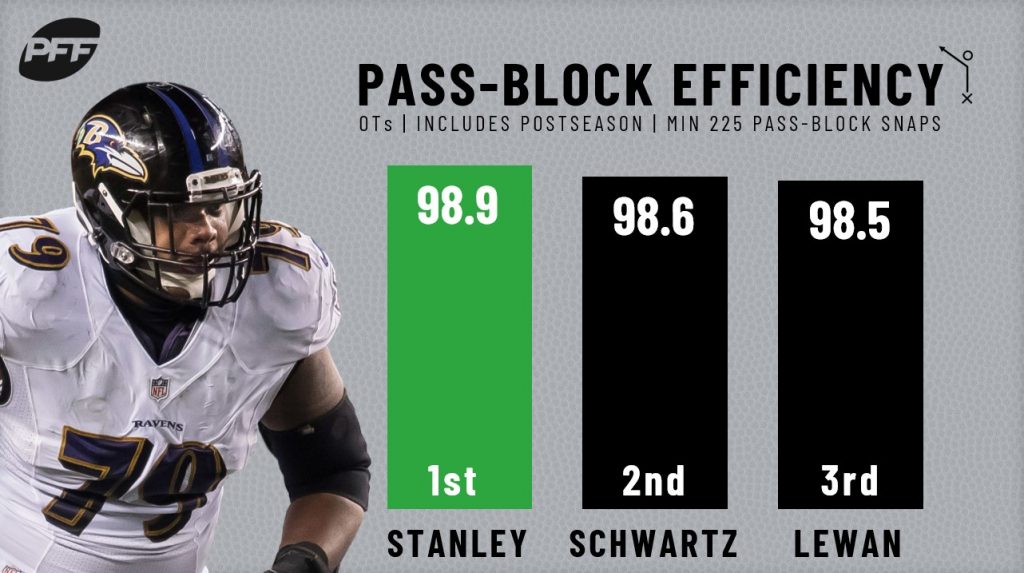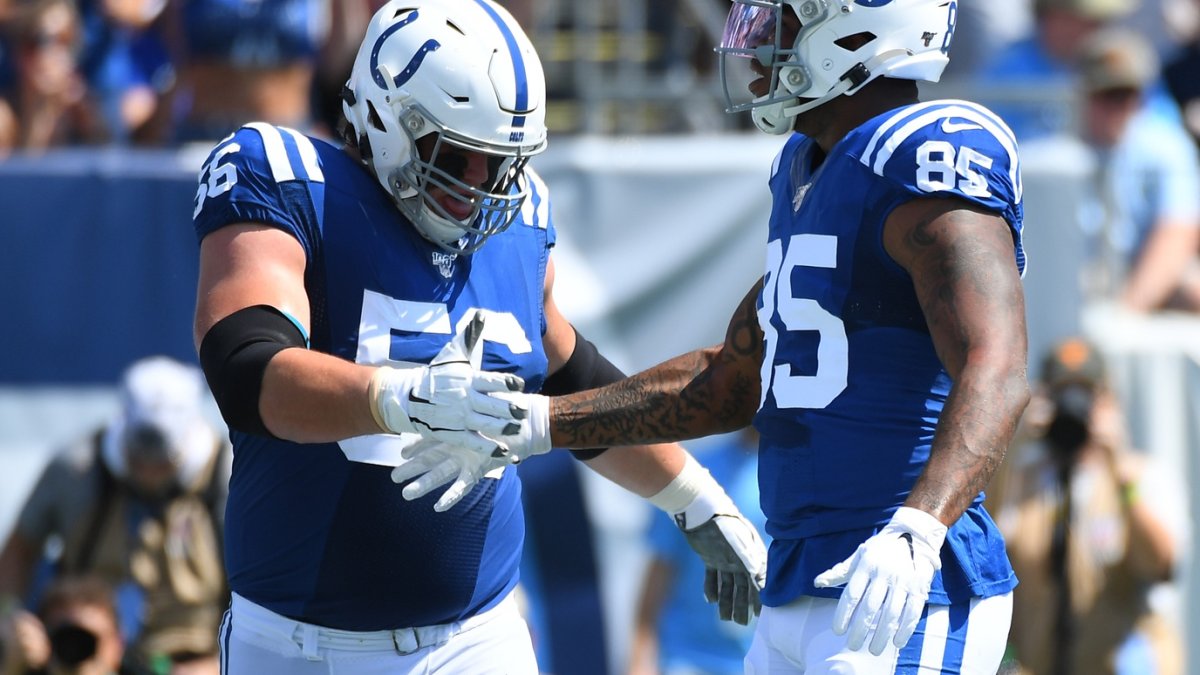PFF's in-depth charting and advanced stats look beyond the box score to identify key metrics otherwise overlooked across all positions in the NFL. This “Signature Stat Spotlight” series will walk readers through the varying advanced stats and metrics we track for every player at every position in every game.
[Editor’s Note: To dive into PFF’s grading system and Premium Stats 2.0, subscribe to PFF’s ELITE – Monthly or ELITE – Annual subscription.]
Hurries, hits and sacks allowed all come into play for offensive linemen, as does PFF’s pass-blocking efficiency metrics, which measures pressures allowed on a per-snap basis with weighting toward sacks allowed. The formula: 1 – (Sacks + Hits) / (2) + (Hurries) / (2) / (Total Pass-Block Snaps) * 100. All of which can be found in Premium Stats 2.0, which is made available to PFF's ELITE subscribers.
We'll also highlight positive and negative run-block percentages, blocks charted as “beaten by defender” and pressure percentage allowed. Though such stats aren’t made available in Premium Stats 2.0, they’re often referenced in our Premium Content made available to EDGE and ELITE subscribers.
Signature Stat Spotlight Series:
QB | RB | WR | TE | OL | DL | LB | CB | S
Pass-Blocking Efficiency
Baltimore Ravens fourth-year offensive tackle Ronnie Stanley led all at his position with 300 or more pass-blocking snaps in PFF pass-blocking efficiency (99.3). He allowed just 10 total pressures across his 515 pass-blocking snaps (includes postseason) in 2019. As a result, Stanley was named the PFF Pass Blocker of the Year this past season.

Four other NFL offensive tackles recorded a PFF pass-blocking efficiency above 98.0 in 2019, including Mitchell Schwartz (98.6), Taylor Lewan (98.5), Ryan Ramczyk (98.2) and Trent Brown (98.1).
Miami Dolphins veteran offensive tackle J’Marcus Webb recorded the lowest PFF pass-blocking efficiency of any qualifier at his position in 2019 at 93.4. He allowed 39 total pressures across 348 pass-blocking snaps, including 29 hurries, six hits and seven sacks. Webb was also the only NFL offensive tackle to recorded a PFF pass-blocking efficiency below 94.0 this past season.
Stanley’s teammate, veteran guard Marshal Yanda, led all qualifiers at his position in PFF pass-blocking efficiency (99.0) in 2019. He allowed just 10 total pressures (nine hurries, one sack) across his 534 pass-blocking snaps on the season. Oakland Raiders’ Richie Incognito and New England Patriots’ Joe Thuney finished second and third behind Yanda at 98.8 and 98.7, respectively.
Minnesota Vikings guard Pat Elflein recorded the lowest PFF pass-blocking efficiency (95.6) of any qualifying guard in the NFL and allowed 38 total pressures in the process.
Raiders center Rodney Hudson led all qualifying centers in PFF pass-blocking efficiency at 99.7 in 2019, as he allowed just two hurries and one quarterback hit all season long. Kansas City Chiefs’ Austin Reiter and Jacksonville Jaguars’ Brandon Linder were the only two other NFL centers with 300-plus pass-blocking snaps played and a PFF pass-blocking efficiency above 99.0.
What doesn’t show up in an offensive linemen’s pass-blocking efficiency but does get reflected in his pass-blocking grade are the plays where he gets beat by the defender. This is charted when an offensive lineman is beaten by his opposition, but the pass gets off before the defender can record a pressure.
Here, Pittsburgh Steelers’ T.J. Watt puts Tevi in the spin cycle and is charted for being beat by the defender without allowing pressure because quarterback Philip Rivers gets the pass off quickly. This is one of the 37 times Tevi was beaten by his defender without allowing pressure, tying New York Giants’ Chad Wheeler for the league lead.

Watt is also graded positively for this play but doesn’t add a pressure to his pressure total, which we’ll get into later in the Signature Stat Spotlight series when we dive into defensive linemen.
Positive/Negative Run-Blocking Percentage
Going away from the passing game, another advanced stat we’ll sometimes reference in articles and have used in previous draft guides is positive and negative run-block percentage. The formula: (Positively Graded Run-Block Snaps) or (Negatively Graded Run-Block Snaps) / Total Run-Block Snaps).
On every run play of every game, every offensive lineman on the field receives a +/- grade from -2.0 to +2.0. Any play where he’s given a grade greater than 0.0, it’s charted as a positively graded run-block snap and vice versa.
Philadelphia Eagles offensive tackle Lane Johnson led all at his position with 200 or more run-blocking snaps in positive run-block percentage in 2019. Ramczyk, Lewan, La’el Collins and Brown rounded at the top five offensive tackles in positive run-block percentage. Stanley recorded the lowest percentage of negatively graded run-blocking snaps in 2019. He, Laremy Tunsil and Schwartz all finished inside the top-three in terms of negatively graded run-block percentage.
[Editor’s Note: To learn more about PFF’s grading process, please visit this article.]
Eagles guard Brandon Brooks and Indianapolis Colts’ Quenton Nelson ranked first and second, respectively, in positive run-block percentage among all qualifying interior offensive linemen. Ravens center Patrick Mekari and Yanda recorded the two lowest negative run-block percentages among the same group of qualifiers.
To continue to learn more about PFF’s advanced stats, please stay tuned for the rest of our Signature Stat Spotlight Series. Or, better yet, subscribe to PFF’s ELITE subscription to dive into the numbers yourself throughout the offseason and into next season.
Signature Stat Spotlight Series:



 © 2025 PFF - all rights reserved.
© 2025 PFF - all rights reserved.